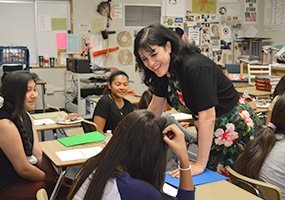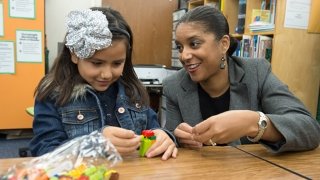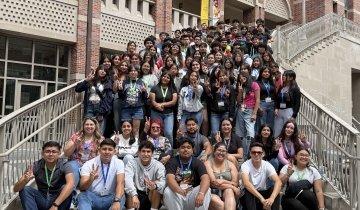Garden Grove Superintendent Gabriela Mafi ME ’00, EdD ’02 keeps fellow Superintendent Stefanie Phillips EdD ’05 in nearby Santa Ana on speed dial, and the pair meet for lunch once a month.
“We know each other well,” says Mafi. “We share issues and best practices across districts, including issues with our boards or collective bargaining.”

Mafi and Phillips are more than just fellow alumnae of USC Rossier — they represent districts that are part of a consortium called CORE, the California Office to Reform Education. They agree that the ability to reach out regularly to other urban superintendents is one of the many benefits of their CORE connection.
The CORE partnership began in 2010 as a collaboration of districts — all facing such challenges as poverty and racial gaps in learning — to explore ways to improve teaching and academic success. In addition to Garden Grove and Santa Ana, the CORE districts include Fresno, Long Beach, Los Angeles, Oakland, Sacramento and San Francisco. Combined, these urban districts serve about 1 million students.
CORE districts have thrust themselves into the vanguard of the nationwide accountability discussion by working collaboratively to create a shared data system that helps them work within and across local districts to improve student outcomes.
CORE’s unique system seeks to measure not only academic results but also nonacademic factors. Those include chronic absenteeism, suspension and expulsion rates, students’ social-emotional skills (growth mindset, self-efficacy, self-awareness, social awareness) and school climate and culture (feelings of safety and connectedness, opportunities for meaningful participation and the quality of relationships between students and staff).
"A REALLY GREAT THINK TANK"
Member superintendents meet formally once a quarter and informally — by phone or in person, in twos or threes — much more often.

Michelle King EdD ’17, a CORE colleague who leads the Los Angeles Unified School District, says the collaboration with other CORE superintendents has helped her handle the stresses of the pressure-cooker job she took on in January 2016 in California’s largest school district. (Mafi is the veteran of the trio, with nearly four years at the helm of Garden Grove’s schools, and Phillips is also relatively new, having taken over Santa Ana Unified in July 2016.)
“Being a superintendent is a rewarding, albeit an extremely challenging, job,” says King, who was recently named Superintendent of the Year by the National Association of School Superintendents. “Having other superintendents to talk to and share insights with is so important. CORE has given me the opportunity to make and expand these key relationships across the entire state.”
Phillips says she feels like part of a “really great think tank” that encourages the sharing of best practices and ideas. “It has been a safe place to really explore not just what the research says but how that has been implemented in real life,” she says.
RESEARCHERS ARE ALSO BENEFITING FROM THE CONNECTIONS THAT ARE TAKING SHAPE IN CORE
RESEARCHERS ARE ALSO BENEFITING FROM THE CONNECTIONS THAT ARE TAKING SHAPE IN CORE
“We’ve found that educators are overwhelmingly supportive of this notion of measuring schools in a more holistic way,” says Julie Marsh, an associate professor at the USC Rossier School of Education. “They have been frustrated by the overreliance on test scores in two subject areas — math and English-language arts.”
Marsh is part of a team tracking the CORE districts’ progress for PACE, Policy Analysis for California Education (See “Setting the Pace,” p. 6). PACE and CORE are partners in the effort to weigh results and share an agenda that not only supports the districts’ own goals but also informs state-level policy.
The research is helping to make CORE districts part of the broader conversation about education accountability and continuous improvement in California and throughout the nation.
“CORE has allowed our district to have a greater voice with state and federal officials,” says Mafi. “Our students and needs are being discussed at an advocacy level in a way they haven’t been before.”
GETTING TO THE CORE OF SOCIAL-EMOTIONAL LEARNING
CORE districts are among the most multicultural in the nation. As schools grow more varied — in terms of race, culture and economic backgrounds — many educators are finding it valuable to look at students’ “social and emotional” skills to learn why some children thrive and others struggle.
CORE is delving deeply into an exploration of how these factors affect student performance. Is their school welcoming? Do they feel they belong? Do they feel comfortable asking questions in class, or do teachers discourage them? Do students give up easily, or do they have the sort of grit and determination that would serve them well in college and career? The districts are also seeking to engage more with parents on these topics.
Researchers like Marsh and postdoctoral fellow Michelle Hall PhD ’16 are then using the data to examine how districts are using this information to advance social-emotional learning and build supportive climates.
School staff and human resources consultants are working together in this regard, says Phillips, who also has an MBA from UC Davis. “They see what’s working, and it really changes the conversation,” she says. “People then ask: Is our school climate suitable? How is that district able to offer this or that program, yet I’m not able to do the same? Is there a training gap? A program gap? Where are we missing the boat?”
King has also seen the benefit of CORE’s wider research to her own district.
“We didn’t have concrete data on how kids feel and the relationship that has to attendance and dropouts,” she says. “We’re starting to look at achievement levels based on some of these pieces. Self-regulation [how students control their own behavior] is another one. We hadn’t looked at it that much until CORE introduced us.”
The new emphasis has made Mafi realize that districts need to look more closely at issues like bullying and teacher expectations around poverty’s effect on students to see how those factors are affecting learning.
In Phillips’ view, “the research is phenomenal.” Over time, she and others acknowledge, CORE will be able to provide much more robust analysis than any district could on its own.
“I wouldn’t have been able to design data systems without CORE,” she says.
One example: The superintendents say CORE recently identified a troubling math gap for African American and Latino students in fourth through eighth grades. The superintendents enlisted the help of consultants from the Carnegie Foundation for the Advancement of Teaching to dig deeper into the phenomenon.
“Traditionally in Garden Grove,” says Mafi, “our math scores have been higher than our English-language-arts (ELA) scores because we have a large number of English learners. Now
our ELA scores are higher than the math scores. That’s perplexing, and we need to dig deeper.”
CORE hopes to benefit from what Carnegie calls “improvement science” — the use of vigorous inquiry to solve a specific problem of practice. Marsh says she and other PACE researchers are in the field now, gathering information from educators in CORE districts and schools that they hope will identify practices that advance students’ social and emotional learning and relate them to students’ ability to learn math.
Although it’s too soon to evaluate CORE’s effect on student achievement, Mafi, Phillips and King agree that CORE is influencing the conversation about school accountability and student success.
As for what lies ahead, King says: “The most exciting thing is the ability to change the game.”
“You have a group of large urban school districts coming together, and you have the synergy that comes from that,” she says. “We have voice and influence at the state level. We’re going to be able to trailblaze in the future and have an impact on what public education looks like in the state of California.”
California’s biggest districts are changing how education accountability works
CORE districts emphasize better metrics
After relying for many years primarily on standardized-test scores to evaluate schools’ success or failure, the state of California recently embarked on a shift to multiple metrics. As early adopters of more robust data-driven accountability strategies, CORE districts are helping to lead the way.
“Luckily for California, there is much to be learned from the CORE districts about how local leaders can work together to improve student outcomes.” That was one conclusion of a 2016 report by Policy Analysis for California Education (PACE).
“The ultimate goal of CORE is that you would glean lessons around policy and practice that could be shared and taken up across the different districts,” says Julie Marsh, an associate professor at the USC Rossier School of Education and co-director of PACE.
Rick Miller, executive director of Sacramento-based CORE, applauds the change to a broader array of metrics.
In 2010, Miller was a deputy superintendent at the California Department of Education when the superintendents of Long Beach and Fresno unified school districts approached him about developing a means for big urban districts to collaborate to raise the quality of education. Miller left the state agency and raised money from philanthropy to launch the nonprofit California Office to Reform Education (CORE).
“Teachers working together can get better,” says Miller. “Why not districts? There is no need for them to be in isolation. They can work together, share struggles and get better together.”
Miller praised the CORE districts’ superintendents for setting priorities germane to their individual districts even as they collaborate. Santa Ana, for example, has focused on how to assess and improve math performance. Garden Grove, meanwhile, has demonstrated how a central office can lead change by interacting effectively with school sites. Los Angeles, the state’s largest and most complex district, has worked to develop robust data on schools’ “social-emotional” factors, a tricky realm.
“Think of the complexity of what CORE is trying to do,” says Marsh. “Measuring math skills and knowledge on a standardized test is more efficient. Measuring additional outcomes, such as social-emotional skills, is more expensive and complex.”
CORE districts, she adds, need time to help educate teachers, staff and parents about these notions and how to build best practices into the classroom.





